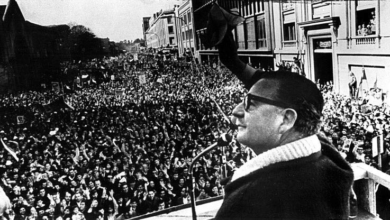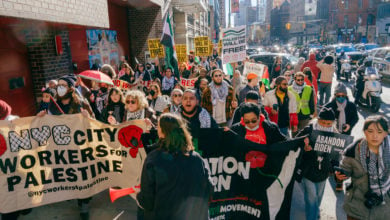The writer submitted this exclusive to PSLweb.org from Brazil.
Sérgio Cabral, the new governor of Rio de Janeiro, Brazil, is on a crusade to escalate state repression. Soon after assuming his new post on Jan. 1, Cabral formally called on the federal government to provide assistance in the form of military and federal troops. The request came as no surprise, as Cabral had already suggested it well before taking office.
The mass media is supporting the governor’s plan. However, a series of attacks against police stations and a
|
The Jan. 8 episode of the popular prime time soap opera Páginas da Vida (Pages of Life) featured a character reading a magazine article and positively commenting on the new governor’s assessment of the “terrorism” situation—a label that has been used not only by Cabral but also by President Luís Inácio “Lula” da Silva. Lula is now talking about a possible “terrorism law” that would certainly create new repressive powers.
The federal government has already responded positively to Cabral’s request for the military to take over patrolling near military bases in the state, allegedly to make local police available for deployment elsewhere. Although the legality and details of such a deployment remain to be worked out, it is clear that the federal and state governments are working hand-in-hand to make it happen.
Police killings normal
Military bases in Rio de Janeiro are concentrated near the poorest neighborhoods—the very same that are often the targets of state violence. The increased military presence would only bring more fear to these communities. Countless atrocities have been committed against these vulnerable populations under the guise of “fighting drug trafficking.”
São Paulo and Rio de Janeiro have particularly high numbers of police killings. Amnesty International reports that between 1999 and 2004, more than 9,000 cases of police killings were recorded in the two states—the majority labeled as “self-defense” by the police with minimal investigation to back the official story.
The numbers do not reflect the actions of death squads made up of retired police or police out of uniform. One such action was carried out on March 31, 2005, when police officers shot indiscriminately at passersby while driving through the Baixada Fluminense district. The massacre left 29 dead and one wounded—the largest such massacre ever in the state of Rio de Janeiro.
Violent state repression in Brazil is not an urban phenomenon alone. Rural workers struggling for agrarian reform—guaranteed by the constitution—are often targeted by the police and paramilitaries organized by the landowners themselves. Perhaps the most well-known is the massacre of El Dorado dos Carajás on April 17, 1996. Nineteen landless demonstrators were shot and killed by the state police and three more would die a few days later from their wounds. As of April 2006, 10 years after the killings, only 2 out of the 142 police officers involved had been held partly responsible for the murders.
The ‘Caveirão’
Residents of the communities are already mobilizing. The Network of Communities and Movements against State Violence (NCMSV) organized a rally on Jan. 8 with 20 representatives of communities in Rio de Janeiro in front of the Guanabara Palace to demand a meeting with Cabral. Among those present were many who had lost their sons, daughters and other loved ones to police brutality.
The poor communities have also been struggling against an important tool of state terror, the “Caveirão” (“Big Skull”). Named after the logo of the infamous Special Police Operations Battalion (BOPE in its Portuguese initials), the Caveirão is a fully-armored military-style vehicle with high caliber weapons used during raids deep into the favelas—shantytowns scattered across the city.
Allegedly a tool against drug trafficking, the Caveirão fully conceals the identity of the cops inside, who are free to carry out whatever atrocities they wish with guaranteed impunity. It is not uncommon for the Caveirão to drive through the streets of the favelas warning the children to run away before a shoot-out.
Cabral had already agreed to meet with representatives from NCMSV on Dec. 7, 2006, well before he had taken office, but the meeting never took place. The NCMSV has given the governor until Jan. 31 to arrange the meeting. It plans to organize buses from its communities to a larger demonstration should the governor fail to respond.
The community leaders hope to present a number of demands including police accountability, the end of
 Network of Communities and Movements against State Violence Jan 8. rally in Rio de Janeiro at the Guanabara Palace. The banner reads “The rich want peace so that they can stay rich. We want peace so that we can stay alive.” Photo: Silvio Rodrigues |
Rich and the poor
Nevertheless, Cabral is working to turn his state initiative into a regional one. The very next day after the rally organized by NCMSV, Cabral held a meeting with the governors of São Paulo, Minas Gerais and Espírito Santo to inaugurate a regional committee for “public security.” These four southwestern states account for over 40 percent of the country’s population and the first three are major economic centers. Among other demands, the group is asking the federal government for additional funds, modern equipment and intelligence support for police operations.
Brazil is the largest economy in Latin America, yet it has a highly uneven wealth distribution among the population. This basic contradiction creates the material conditions for the rising crime rates in metropolitan centers.
With over 75 percent of the population living is densely populated urban areas, the poor struggle not to sink even further into abject poverty with little chance of success, while the wealthy few enjoy a life of privilege sometimes only a few blocks away.
Poverty is of much concern to the capitalist class, although not due to the suffering it causes many. The favelas are much reviled by the rich who say their presence brings down the value of their real estate.
The tourism industry has seen its multi-million dollar profits fall due to homelessness and crime in the streets. The wealthy are demanding a safe environment where they can enjoy their wealth.
The upcoming Pan-American Games in Rio de Janeiro in July 2007 are also a hint that the policies of the new governor are an attempt to “clean up” the city before then.
Some of the federal police scheduled to come as reinforcements next month ahead of the tournament were instead deployed on Jan. 9 in the wake of Cabral’s call for federal intervention. The much-anticipated games are an opportunity for the ruling class to showcase Rio de Janeiro and boost the tourism industry.
In essence, the policies of the new government aim to alleviate all of the “afflictions” of the capitalist class and none of those of the workers and the poor. The escalation of state repression will not reduce homelessness, hunger, unemployment or lack of access to healthcare. Rather, it will further protect the very inequalities that cause such hardships to the working class.







